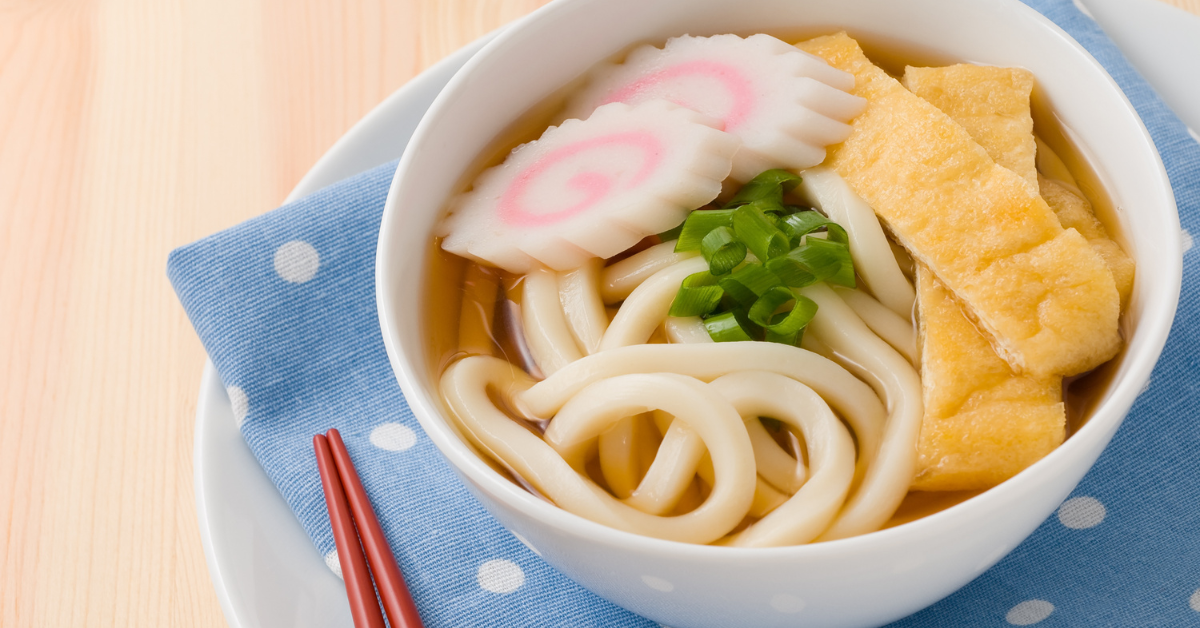Udon is more than just thick wheat noodles in Japan. It is a cultural staple representing warmth, regional identity, and culinary simplicity. This article guides you through udon’s origins, famous local varieties, etiquette, and deeper meanings so you can experience it not only as food but as part of Japanese daily life.
WHAT IS UDON
UNDERSTANDING UDON NOODLES
Udon is among Japan’s most iconic noodles, made from wheat flour, water, and salt. Its thick, chewy body sets it apart from soba or ramen. Udon is served hot in a mild broth or cold with dipping sauce, making it a dish suited for any season. Hot udon comes with soy-based soup, topped with green onions, tempura, or kamaboko fish cake. Cold udon, called zaru udon, is chilled and eaten with dipping sauce, often accompanied by wasabi and grated ginger. It is widely considered easy to digest, enjoyed by people of all ages. Many local shops serve a basic bowl for under 500 yen, making it affordable and accessible nationwide. Udon represents comfort food and community spirit, found at train stations, shopping centres, and traditional restaurants. For Japanese locals, it carries memories of childhood, school trips, family meals, and casual dining, evoking feelings of home and warmth that transcend mere taste.
THE HISTORY OF UDON
ORIGINS AND DEVELOPMENT
Udon was introduced from China as wheat dumplings during the Nara or Heian periods. Japanese chefs adapted these into stretched noodles by the Edo period, leading to regional styles shaped by local ingredients and tastes. During the Edo era, street vendors sold udon from portable stalls called yatai. This affordable street food became a daily staple for samurai and merchants. Today, udon remains a part of home cooking and restaurant menus, with new varieties such as curry udon or carbonara-style udon reflecting modern tastes. The continuity from ancestors to contemporary chefs demonstrates Japan’s dedication to preserving food heritage while embracing creativity. This duality of tradition and innovation keeps udon relevant in modern society.
REGIONAL VARIETIES OF UDON
FAMOUS TYPES OF UDON NOODLES
Japan features many regional udon types reflecting local climate and agricultural products. The table below summarises notable varieties and their unique traits.
| Region | Name | Characteristics |
|---|---|---|
| Kagawa | Sanuki Udon | Thick, chewy noodles with firm texture, served with light soy broth or cold dipping sauce |
| Akita | Inaniwa Udon | Thin, smooth noodles with a glossy finish, often enjoyed cold |
| Nagoya | Kishimen | Flat, wide noodles in rich soy-based broth with bonito flakes |
| Osaka | Kitsune Udon | Served hot with sweet fried tofu called aburaage |
| Fukuoka | Goboten Udon | Topped with burdock root tempura, offering earthy aroma |
These variations show Japan’s regional pride and culinary adaptability, offering different textures and flavours that enrich travellers’ journeys.
NUTRITIONAL BENEFITS OF UDON
Below is a table summarising nutritional elements found in a standard serving of udon noodles.
| Nutrient | Amount per 100g | Benefit |
|---|---|---|
| Calories | 105 kcal | Provides energy with moderate calorie content |
| Carbohydrates | 21.6 g | Main energy source |
| Protein | 2.6 g | Supports muscle maintenance |
| Fat | 0.2 g | Low fat, easy to digest |
| Sodium | Varies by broth | Essential electrolyte balance |
Udon is low in fat and easy on the stomach, making it a suitable choice for light yet filling meals.
MAIN INGREDIENTS OF UDON
This table outlines the basic ingredients used in traditional udon making.
| Ingredient | Role | Notes |
|---|---|---|
| Wheat flour | Base for noodle | Strong flour creates elasticity |
| Salt | Strengthens dough | Added to flour and water |
| Water | Forms dough texture | Adjusted by region for humidity |
Each ingredient is simple, but technique transforms them into a culinary experience.
HOW TO ENJOY UDON IN JAPAN
DINING ETIQUETTE AND TIPS
Eating udon in Japan involves cultural etiquette. In casual shops, order from vending machines by choosing your dish, paying, and giving the ticket to staff. Traditional restaurants accept direct orders. Slurping noodles is common, showing appreciation and enhancing aroma. For cold udon, dip small portions into the sauce to keep it clean. Free toppings such as tempura crumbs, green onions, grated ginger, and spicy shichimi pepper are often available. Return trays and sort dishes properly if self-service. Avoid talking loudly, and finish your meal efficiently during busy hours. Some regions offer udon-making workshops where visitors knead and cut noodles with instructors. Participating in these experiences deepens appreciation for the skill involved and the cultural significance of this beloved noodle.
UDON AS A CULTURAL EXPERIENCE
BEYOND A NOODLE DISH
For many Japanese, udon is a symbol of hospitality and community ties. Local festivals promote regional udon, preserving traditions and supporting producers. Families cook udon for the sick due to its digestibility, and festive versions with tempura celebrate milestones. Shops display calligraphy banners showing their noodle-making philosophy and water source, reflecting pride. Learning these backgrounds transforms udon from a simple meal into cultural heritage. Visitors gain insight into values such as harmony, gratitude, and seasonal respect by enjoying regional udon. Each bowl embodies centuries of techniques and wisdom, reminding people of nature’s blessings and human effort.
CONCLUSION
DISCOVERING THE WORLD OF UDON
Udon exemplifies Japan’s culinary philosophy: simple ingredients elevated through care and technique into dishes that nourish body and spirit. Its wide variety, from hearty Sanuki to elegant Inaniwa, offers travellers a journey through regional cultures. Tasting different types or joining udon-making workshops provides understanding of Japan’s dedication to tradition, innovation, and hospitality. Whether it is a quick bowl or a specialty meal, udon invites everyone to savour the warmth and dedication embedded within each noodle.






